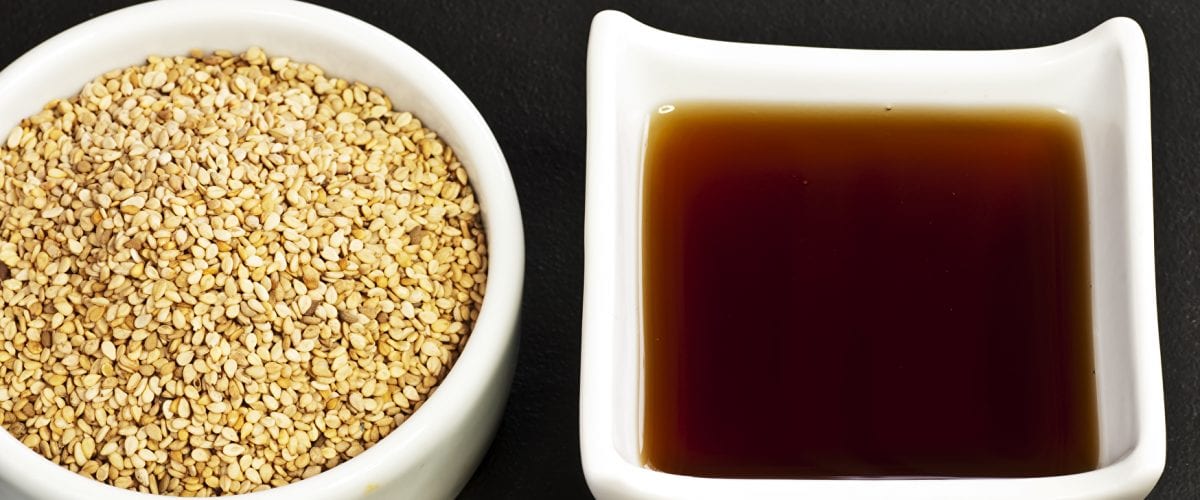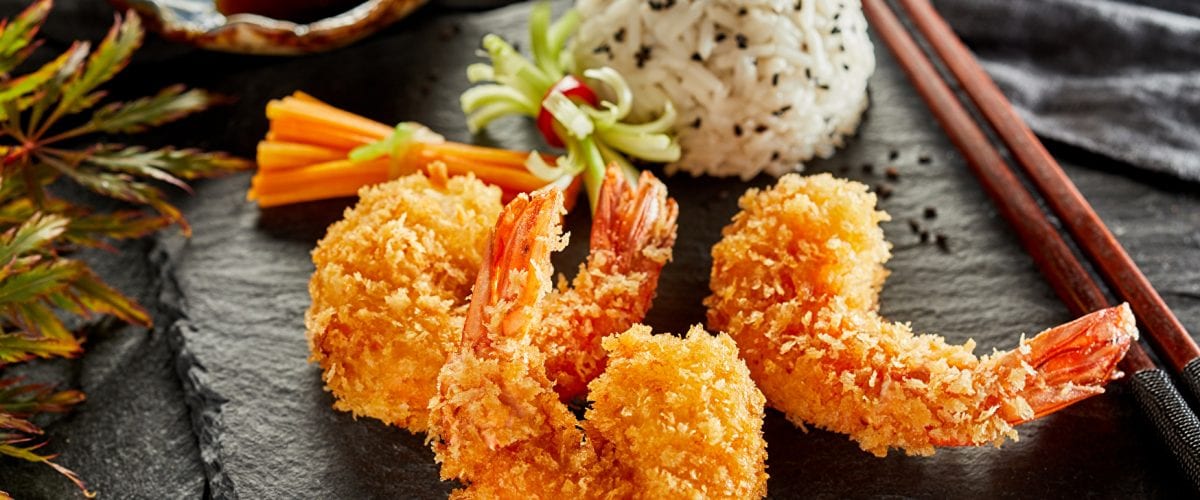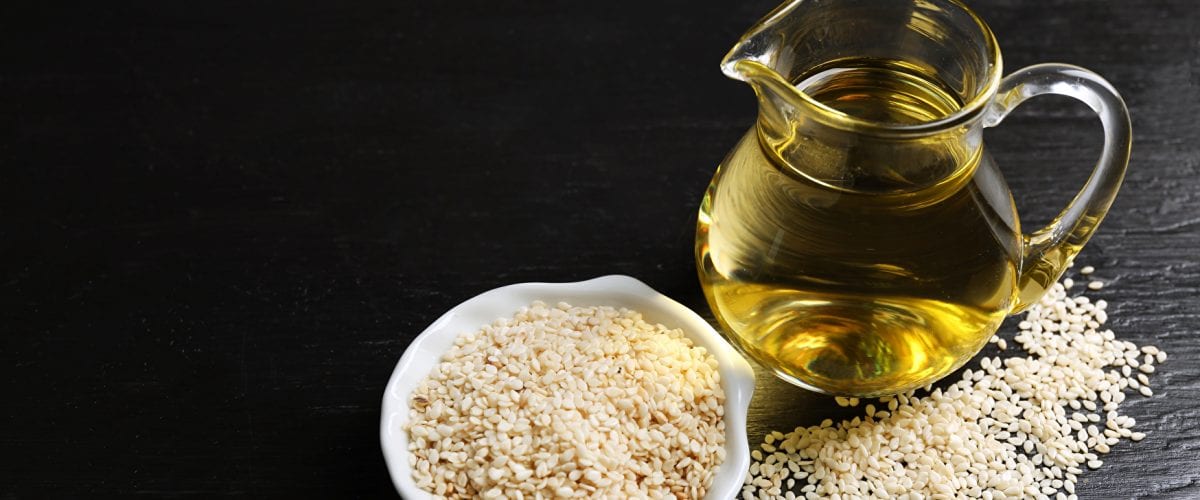Whether it’s light or dark sesame oil, we explain the difference and what you can use which oil for.
Edible fats and oils can be found in every kitchen. The choice available in most kitchen cupboards extends from olive oil to rapeseed oil and sunflower oil. But do you also have sesame oil at home? If you have not tried sesame products before, then you certainly will after reading our article.
The sesame plants are plants of the species Sesamum indicum. Its botanical name suggests that it thrives in India and in areas with similar climatic conditions. Sesame and products made from sesame are therefore very popular in Asian cuisine. Let’s take a closer look at sesame.

Fat or oil? Healthy or unhealthy?
These are the questions that trip us up again and again when dealing with fats and oils. So, what is the correct name? The definition is clear. If the product is solid at 20 °C, it is referred to as a “fat”. Oils, on the other hand, are liquid at the same temperature. These properties are related to the fatty acid composition. If the fatty acids contained are predominantly saturated, then in most cases they are fats. These products are then solid at 20 °C. Animal fats often have this fatty acid composition – e.g. butter or lard.
If, on the other hand, the product contains many unsaturated fatty acids, then the product is liquid at room temperature and is therefore referred to as an oil. This is the case with many vegetable oils. As always, there are also exceptions. Coconut oil, for example, contains almost exclusively saturated fatty acids. Sesame oil consists of 82% unsaturated fatty acids. By comparison, butter has only 25% unsaturated fatty acids.
And which is the healthy variant? There is no right answer to this question, as all the different fatty acids are important in their own way. However, researchers agree that too many saturated fatty acids have a negative effect on the heart and circulation. It’s therefore worth noting the rule of thumb that fats that are solid at room temperature should be consumed more sparingly than oils. Basically, all oils and fats have a very high energy content: a whole nine kilocalories per gram. This is more than twice as much as carbohydrates and proteins provide for us.

Light and dark sesame oil – what’s the difference?
In many supermarkets there’s not just one, but two varieties of sesame oil – light and dark. Does it make a difference which version you buy? Absolutely! The two oils are processed differently and therefore have different properties and uses in the kitchen. Whether light or dark, both oils are extracted from the seeds of the sesame plant. Half of the seeds consists of oil which is obtained by pressing.
To obtain the dark oil, the seeds are roasted before pressing. The roasting produces aromas which mean that the dark sesame oil is ideal for seasoning food. The roasted sesame seeds are cold-pressed. This gives the dark sesame oil an intense and characteristic taste of its own – nutty and roasted. However, it should not be heated to high temperatures, as it contains free fatty acids that cause it to smoke at lower temperatures. Instead, it is more suitable as a seasoning ingredient. The dark oil is a great addition to salad dressings or ready-made dishes.
Unroasted sesame seeds are used to produce the light, yellowish oil. In most cases, it is not cold-pressed but refined for further processing. For example, after pressing, the seeds are additionally treated with a solvent to extract the remaining oil. This makes the yield higher. The oil must then be cleaned. The result is an oil that can be used in many ways, can be heated to high temperatures and has a long shelf life. However, since odorants, flavours and colourants are also removed, the oil loses some of its character during refining and tastes relatively neutral.
Storing sesame oil correctly
Sesame oil is not exactly the cheapest oil on the market – it’s a real delicacy. But take care: once opened, the oil does not last forever. Although there is no microbial spoilage of the oils, which can be dangerous to health, they can become rancid. This means that the fatty acids oxidise (when they come into contact with oxygen) and are then inedible.
The more unsaturated fatty acids there are, the faster these processes take place – and sesame oil contains plenty of these unsaturated fatty acids. Dark sesame oil is even more prone to becoming rancid as it contains free fatty acids that oxidise more easily. These free fatty acids have been removed from the light-coloured refined oil, making it more stable to store.
Once opened, the oil bottles – whether they contain refined or cold-pressed oil – should therefore be tightly closed so that as little oxygen as possible gets to the oil. Opened bottles should also be kept in the refrigerator, as this slows down the chemical processes. Dark bottles or dark storage also help to delay rancidity.

Culinary pleasure thanks to sesame oil
We now know that there’s not just one, but two different sesame oils. However, very few recipes differentiate between dark, cold-pressed sesame oil and light, refined sesame oil. There is only one thing to do here: work it out for yourself. Is the oil heated in the recipe? If so, you should go for the light oil. Is the oil added at the end of the cooking process? If so, the spicy, dark oil is ideal – but don’t heat up the dish too much afterwards!
The light sesame oil is often used for frying in Asian cuisine, for example for preparing tempura coatings. The ingredients (e.g. prawns or pieces of vegetables) are dipped into a batter and then fried. You can then enjoy the tempura dish with a tasty, usually slightly sour sauce. With the dark sesame oil, you can give all kinds of dishes a very special twist. Our tip is to try a small spoon of the dark oil to get an impression of the smell and taste. These impressions are strong and characteristic; you may be able to sense taste notes such as grass or hay, sweet, fungal, smoky, roasted, earthy or nutty.
Following a proper tasting, you will definitely get a feel for which dishes gain character with a little shot of the dark sesame oil. The potential for experimentation is limitless and the taste of your food will be transformed as never before.






